| Figure 1: 21 Week Old African Black | Figure 2: 40 and 44 Week Old Chicks |
||
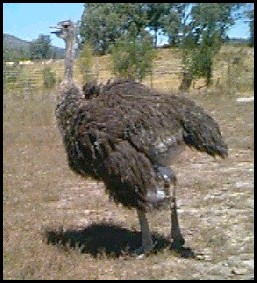 |
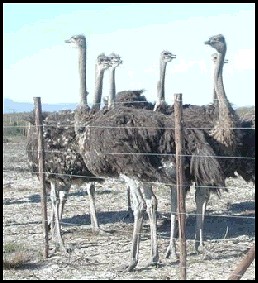 |
Influences of Ostrich Skin Quality . . . Age or Nutrition?
by Fiona Benson and Daryl HolleA major factor that has held back development of our industry has been statements such as the following quote:
Quote:
“Farmers are daily told by animal nutritionists that they can reach
slaughter weight at the age of 9 months. A 9 month old bird does not
produce an acceptable leather. The recommended age for slaughtering is
13 months at least. I would like to state that in the recent times,
nutritionists had short-term goals over-emphasizing weight as a factor
and cause substantial damage to the quality of raw materials,
especially skin substance and quill development. I would like to say
Mr. Chairman, they have pushed too far, the tanneries will change the
rules to ensure good quality ostrich leather." [1]
End Quote
These statements may be made in good faith from the evidence those
making these statements have been presented with in skins. What has
been missed is taking time to understand exactly what the different
nutritionists are doing and how this is being adopted on farm. To
achieve good weight gains in fact requires a healthier diet, which
results in improved quality of skin substance and quill development.
| Figure 1: 21 Week Old African Black | Figure 2: 40 and 44 Week Old Chicks |
||
 |
 |
This
paper aims to discuss some of these variables to demonstrate why it is
now proven that young slaughter birds can produce skins that are very
acceptable to the market and to demonstrate that age is not the
criteria but rather maturity and feather development that is controlled
through the nutritional and feed management programs on farm.
Materials and Methods
A number of birds have been raised to observe responses to the Blue
Mountain Feed rations in South Africa. The first chicks from my own
production were retained from November 2000. Chicks were artificially
hatched from eggs from our own breeders. These breeders were raised
from day old chicks that were originally taken in for contract rearing
to 50kgs. Chicks were tagged at hatch and maintained in batches. No
specific genetic bird material was used for the study.
36 chicks have been slaughtered ranging from 8months through to
14months (35 weeks to 60 weeks of age). 2 of these Chicks were
slaughtered in November 2001 and the balance slaughtered in January
2002. Each skin was uniquely electronically tagged at slaughter and
punched with a unique number.
A second study consisted of 10 birds hatched in the middle of last
winter…July and August 2001 were the wettest recorded for 44 years. As
we are operating from temporary facilities the conditions in which the
chicks have been reared have been far from ideal and were totally
inadequate for our wet winter conditions. This particular batch had to
spend a great deal of their time shut up in a very dark and cramped
area on and off for the first 8 weeks as a result of extended wet
conditions. The stress was such that their feed consumption was 50% of
normal for that age group and they also started “feather pecking”. This
resulted in the chicks being very slow to get going and always behind
what we consider 'normal' for age. At 3 months they stopped the feather
pecking and settled down well but obviously well behind target weights
for age.
At 7 months the feather pecking very suddenly started once more. As I
do not work with them on a day to day basis, I cannot tell you if there
was some stressor that brought back that old habit, but it is my guess
this was the cause. Since these birds would not be held back as
potential breeder stock these chicks were sent for slaughter at the
beginning of February 2002. So not only were these chicks only just 8
months of age, they had also suffered a very slow start in life as a
result of poor environmental conditions.
Photographs have been taken at specific stages of bird development and
skins assessed after slaughter of test batches. The majority of birds
have been retained as future breeder stock. A study of birds raised
under different management conditions demonstrates extremely variable
feather development that cannot be attributed to age alone.
Results
The birds raised on the Blue Mountain Feed rations
clearly demonstrate feather development that is well advanced. There
are variations within similar age groups from batch to batch that can
be directly attributed to certain management factors that will be
discussed later.
When grading the skins at the Crust stage, the tanner was asked to
provide Classifications for each skin based on follicle development. He
chose 4 classes, Class 1 representing optimum and Class 4 follicles
that are too small and of a size downgraded on payment to the farmer.
He reported that most skins they receive from batches of 9 month and 10
month birds are class 4 skins.
Batch 1

Average classification achieved was Class 1.6 and average classification for chicks 10mths and under was Class 1.7.
The Class 3 skins were 1 x 9mth, 2 x 10mth, 1 x 11mth, 1 x 12mth, 1 x
14mth. This clearly indicates that age is not the determining factor.
All skins were of acceptable quill size/follicle development. One point
of interest was a comment on 1 x 14 month skin. The quills were flatter
and less prominent, a factor usually only observed in cull breeders or
birds that are very much older than 14 months.
Skin size is often a problem with slaughtering birds at a younger age.
The birds in these batches 10 months and younger achieved an average of
15.54 sq. ft. All skins achieving well above the minimum size for Grade
A skins (greater than 14sq ft).
Batch 2

| Figure 3: 4 Month Old Chicks | Figure 4: 11 Week Old Chicks |
|
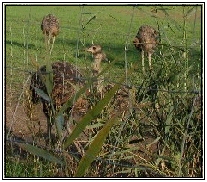 |
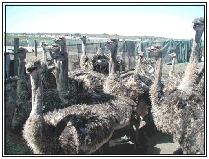 |
The
chicks in Figure 3 are 4 months old. The chicks in Figure 4 are 11
weeks old. It is very clear that provided the Figure 4 chicks continue
to be maintained correctly they will mature very much earlier than
those in Figure 3, where there is already a very clear difference in
growth rate. The chicks in Figure 3 are very typical of many 3 - 4
month chicks seen today.
When the detail of the nutritional factors that make the difference
between acceptable skin quality at younger ages and unacceptable skins
are understood, it becomes very clear why it is possible to raise
Ostrich for early slaughter with very acceptable skins that will be of
a higher standard than currently produced from 14mth old birds. Daryl
Holle of Blue Mountain Feeds has steadily worked for years to develop
feed formulas and nutritional guidelines that bring about faster bird
maturity at a younger age. He has done this through careful study and
use of proper feedstuffs, proteins, minerals, trace minerals, vitamins
and natural additives. The Blue Mountain formulations are designed for
earlier follicle and feather development with skins that are more
“elastic” causing them to be more resistant to skin damage. All of
these things put together result in higher quality skins in much less
time.
Conclusion
The evidence is clear that the skin evaluation done with birds fed Blue
Mountain formulas on our farm certainly proved that good nutrition
affects more things than simply egg production or chick survival. This
study proves that Proper Nutrition influences the age of follicle
development and quality of the skins.
With proper nutrition, there are additional economic benefits. Birds
raised in this manner produce greater meat yields. The meat from faster
grown muscles is more tender, even in colour and has a good aroma. It
is also possible to inventory a lower number of Breeder birds as their
egg production, fertility and hatchability is much higher per bird.
Increasing income from skins, meat and from increased numbers of birds
slaughtered, while lowering the expense per unit produced with earlier
slaughter ages and less Breeder birds is most certainly “the path to
profitability” for the future of the industry.
It is now time that the majority of the industry recognize this fact
and move forward towards those goals as they have clearly been
established as achievable.
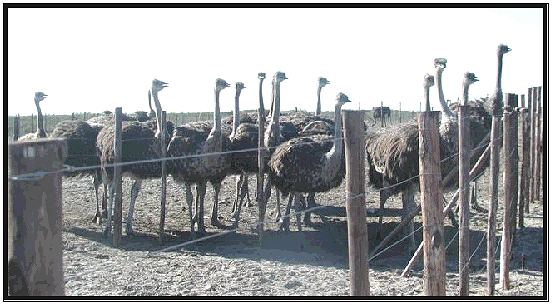
Reference:
[1] Kriek, F Japan’s Economy, IOA Leather Conference, Hong Kong, March 2001
Copyright© of Blue Mountain all rights reserved